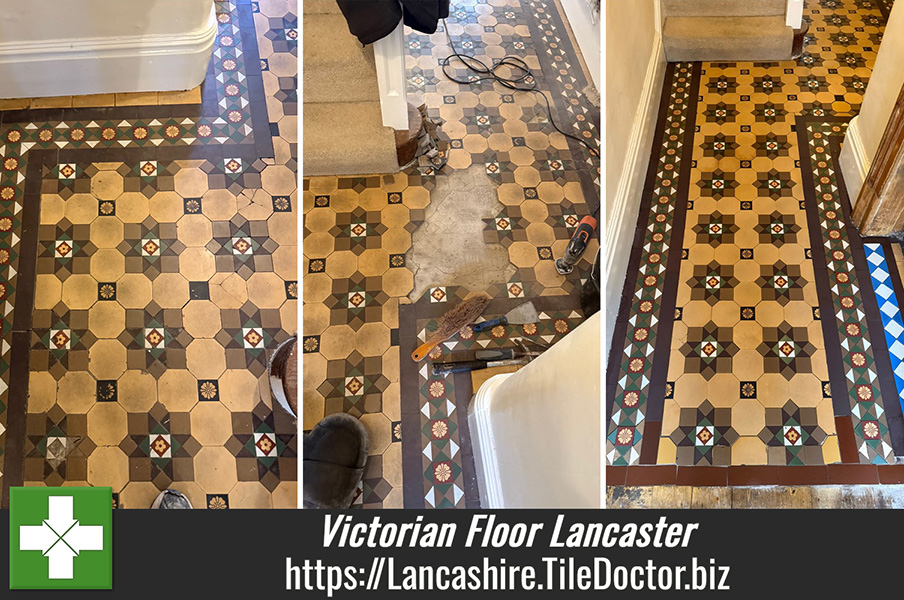Tile Doctor Gel Cleaners Specified for Encaustic Tiled Victorian Floor Restoration in Lancaster
Below is a great example of what we typically do to a restore an old Victorian tiled floor. This particular floor was installed in the hallway of at a house in Lancaster circa 1890 and now 135 years later it was still in place but the years had taken its toll with multiple damaged tiles needing replacement and some had been replaced with cement.
 |  |
The floor was laid in an attractive geometric pattern with lovely detailed encaustic tiles with a rose at the centre of the pattern. These encaustic tiles will have been specially created with compressed cement and whilst we can usually source replacement Victorian tiles the encaustic tiles were custom made and very rare. The only way to find replacements for them would be by trawling reclamation yards or having them specially made at great expense. Fortunately, in this case most of the encaustics were still in good condition which is a testament to the Victorians.
Repairing a Damaged Victorian Tiled Hallway Floor
Before cleaning the floor needed a lot of work to remove the damaged tiles and areas were tiles had been substituted for concrete. This involved using a hammer and chisel to carefully remove the old tile and then clean up the debris. This is delicate work as too much force can lead to more tiles popping out and making the whole project bigger.
 |  |
When the floor was ready new tiles were cut to fit the existing pattern and set in place using a rapid set adhesive. It was also necessary to reset quite a lot of tiles that had become loose. The tiles were then grouted in using a coloured grout to match the rest of the floor. They didn’t use grout back in the Victorian period, it was just cement fortunately I was able to replicate this perfectly.
Cleaning a Victorian Tiled Hallway Floor
When the tiles were set and the whole floor was solid, we were able to move onto the cleaning. This started with the application of Tile Doctor Oxy-Gel worked in with a 200-Grit Milling pad fitted to a rotary buffer. I recommend gel cleaners for this work as they use less water and excessive use of water on an old floor that doesn’t have a damp proof course will take much longer to dry out. After being scrubbed in the gel released the dirt from the tiles which was then rinsed off and vacuumed away with a wet vacuum.
Next step was to give the floor an acid rinse using Tile Doctor Acid Gel scrubbed in with a deck brush. The acid gel further cleans the tiles, removes old grout smears, counters efflorescent salts and neutralises the floor after the use of Oxy-Gel which is alkaline. After another rinse and vacuum the process was repeated in the edges and corners using handheld diamond blocks.
 |  |
Once the tiles were dry, I used a Burr Line pad fitted to a rotary buffer to further improve the appearance of the tiles. Often referred to as magic pads they are really good at finishing off the cleaning and is applied using only water.
Sealing a Victorian Tiled Hallway Floor
The floor was left to dry fully overnight and we called back then next day to seal the floor. Two coats of Tile Doctor Colour Grow sealer were used for this which did a great job. It doesn’t give a shiny finish but the formula contains a colour enhancer that really lifts the colours in the clay. This sealer is also fully breathable which is important when sealing a floor that has no damp proof course as it will allow any moisture from the foundation to rise through the tile.
 |  |
I think you will agree the floor was completely transformed by the work and the new sealer should keep it looking that way for some time to come. For aftercare cleaning I recommended the use of a Neutral PH cleaning product such as Tile Doctor Neutral Clean.

Source: Professional Victorian Floor Tile Restoration Services near Lancaster Lancashire
